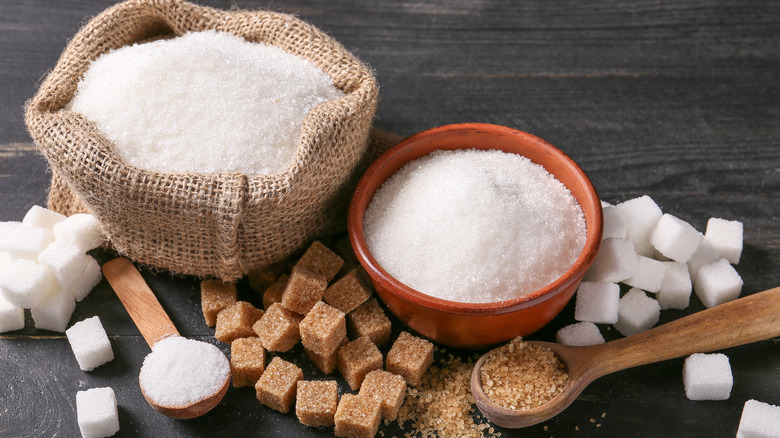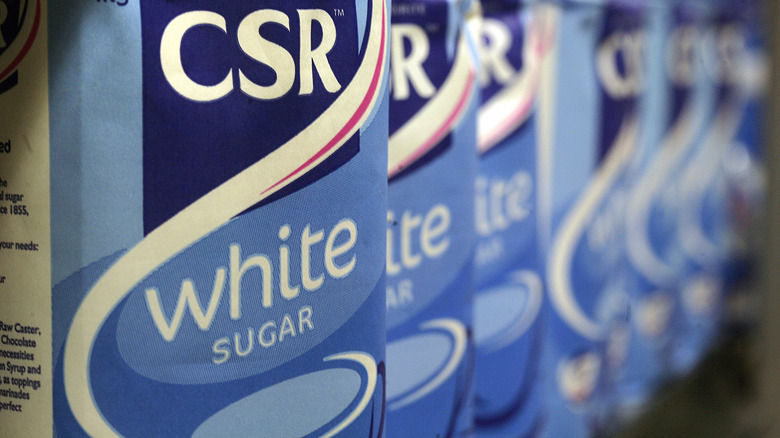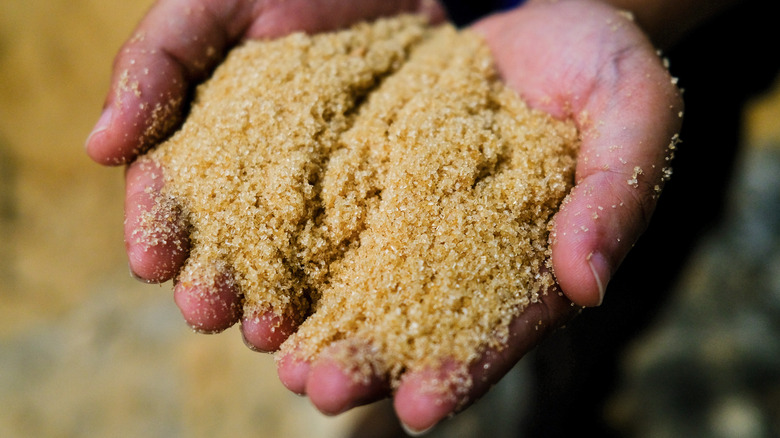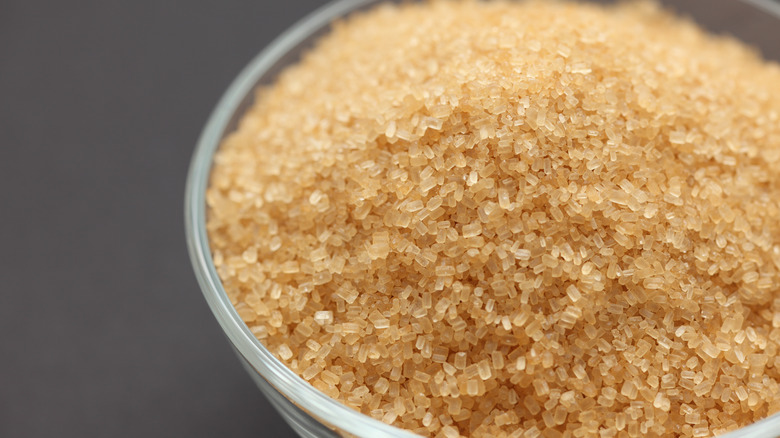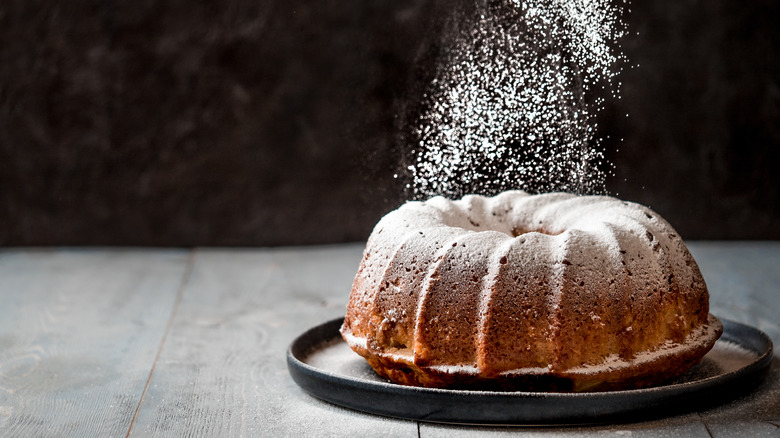The Real Difference Between White Sugar And Raw Sugar
Imagine you are sitting in a cafe, enjoying a coffee sweetened with three or four packets of sugar — nothing fancy, just plain, white sugar. Then you notice that fitness trainer from your gym come in, order coffee, and grab some packets of "Sugar In The Raw." As you watch the trainer stir the bigger, browner sugar crystals into their coffee, you wonder if maybe they know something you don't about sugar. Is raw sugar healthier than white sugar? How does white sugar get so white, anyway? Is it treated with chemicals? If a sugar is raw, does that mean it's not processed at all? Raw sugar may be just fine for coffee, but can I substitute raw sugar for white sugar while baking?
First, let's be clear that "Sugar In The Raw" is a brand name for one particular company's turbinado sugar product (via Cumberland Packing). And turbinado sugar is one of several different types of raw sugar, as the WhatSugar blog explains. Raw sugars endure less processing than white sugar, but they are still processed. The brown color in raw sugar comes from the traces of molasses that remain after processing. White sugars, on the other hand, are highly processed into a pure, white sugar called sucrose. Here's what you should know about these sweeteners.
What is white sugar?
White sugar goes through several steps to get from the farm field to your table. If the sugar comes from sugar cane, it even needs to go through two separate factories, according to The Sugar Association. Sugar beets, on the other hand, can be fully processed in one facility. The finished product is one of the purest food products out there, according to WhatSugar: 99.95% sucrose.
First, juice is extracted from sugar cane or sugar beets. The juice is boiled, spun, melted, filtered, and dried again to remove molasses and other impurities. Processing of white sugar is typically repeated four times, according to The Sugar Association, to achieve the desired level of purity. As The Sugar Association explains elsewhere on its website, white sugar comes in different consistencies, from coarse-grained all the way down to powdered sugar, which has a little added corn starch.
However, The Sugar Association, which represents the sugar industry, glosses over some of the details in white sugar's refining process. As the chemical engineer who runs the WhatSugar blog points out, white sugar can never be labeled "organic" because synthetic chemicals are used to help white sugar attain its high level of purity. Lime is combined with phosphoric acid, sulfur dioxide, or carbon dioxide to clarify the cane juice (via Southern Savers). Isopropyl alcohol is used, too, to help the liquid crystallize.
What is raw sugar?
Unlike white sugar, raw sugar can be labeled "organic" as long as farmers cultivate the sugar beet or cane according to organic standards, as explained in a WhatSugar post about organic sugar. Chemicals are not used in the processing of raw sugar, but the term "raw" should not lead anyone to think the sugar is unprocessed. In fact, raw sugar isn't even raw in the everyday understanding of the word.
The juice derived from sugar beet or cane is boiled to form sugar crystals (via Healthline). Unlike white sugar, raw sugar goes through just one crystallization process, not four, according to a WhatSugar post on raw sugar. Liquid molasses separates from the pure sugar during crystallization, and the whole batch is spun in a centrifuge to separate the loose molasses from the sugar. Some molasses remains inside the crystals, giving raw sugar its brown color. With white sugar, the processing steps are repeated until all the brown molasses is removed.
Raw sugar is found on supermarket shelves under several names: turbinado sugar, demerara sugar, washed sugar, and others. Turbinado and demerara sugar differ in crystal size and molasses content. Turbinado is darker, with up to 3.5% molasses, per Healthline. Demerara has larger crystals and 1-2% molasses. These should not be confused with brown sugar, which is highly processed white sugar with molasses added. Brown sugar is moister and clumpy, while raw sugars are much drier and flow easily from a spoon or dispenser.
Is raw sugar healthier than white sugar?
Is that fitness trainer in our imagined cafe scene, who takes their coffee with "Sugar In The Raw" instead of white sugar, gaining any health advantages? According to SFGate, white sugar has no measurable nutrients, while "Sugar In The Raw," a brand name for turbinado sugar, has small amounts of calcium, iron, and potassium. Mother Jones adds that molasses, which gives raw sugars their brown hue, has antioxidant properties under certain conditions. But the magazine also says that scientists have only reported those antioxidant properties in laboratory cell cultures — not actual living things.
As for the iron, calcium, and phosphorus in raw sugar, Mother Jones offers some useful comparisons. You would need to consume seven cups of raw sugar to get the same amount of potassium found in one banana. You get similar results comparing the calcium in raw sugar with what's in milk, or the iron in raw sugar with the amount of that mineral found in spinach.
In other words, the tiny amounts of nutrients in raw sugar are greatly outweighed by the health risks associated with sugar in general. White and raw sugar both consist almost entirely of sucrose and have the same number of calories. Too much sugar, whether raw or white, can cause obesity, heart disease, diabetes, and tooth decay, according to Healthline. The bottom line: Raw sugar is not healthier than white.
Raw sugar can sometimes sub for white sugar in baking
Unless you are under doctor's orders to strictly limit your sugar consumption, it's okay to indulge occasionally in a sweet, baked treat. But can you substitute raw sugar for white when baking cookies or cakes? You are not going to gain any health advantages doing this, but raw sugar does impart a different flavor to baked goods. While white sugar is just pure sweetness, the small amounts of molasses in raw sugar add what's described either as a "delicate molasses flavor" (via WhatSugar) or "a subtle caramel flavor" (via Healthline).
The texture will be different, too. The coarser crystals that make up raw sugar don't melt when heated, resulting in a grainier texture to baked items (via SFGate). For muffins, that extra texture may not matter. But for something lighter, such as sponge cake, the coarseness may feel out of place.
Cook's Illustrated compared raw and white sugar in a wide range of baked treats and got mixed results. The molasses flavor from the raw sugar was considered an improvement, but texture suffered in baked items with drier batter. The shortbread baked with raw sugar, in particular, came out too grainy. You could even see the sugar crystals in the finished product. The raw sugar dissolved just fine in the wetter layer cake batter, though. Cook's Illustrated recommended grinding raw sugar into a fine powder before adding it to the batter.
